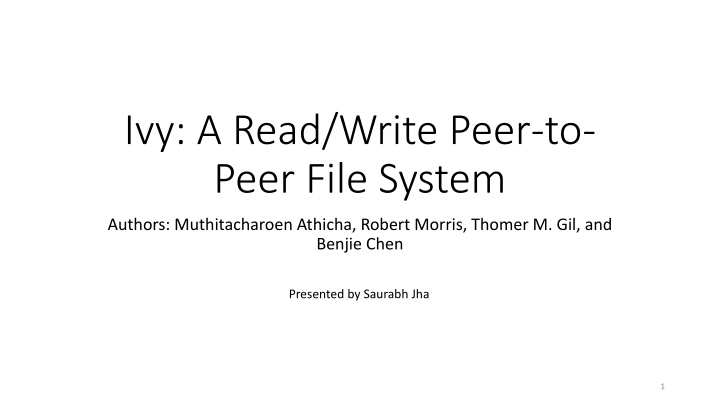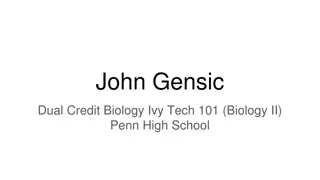Ivy: A Read/Write Peer-to-Peer File System Overview
Introduction to Ivy, a read/write peer-to-peer file system designed to enable easy storage and access of remote files in a distributed manner. The presentation covers the motivation for peer-to-peer distributed file systems, challenges in designing such systems, and how Ivy addresses trust issues and handles multi-user interactions through a log-based approach stored in a distributed hash table. Ivy offers transparent access to files using NFS interface, ensuring consistency and conflict resolution semantics. The discussion also touches upon the architectural design of Ivy and its operational benefits.
Download Presentation

Please find below an Image/Link to download the presentation.
The content on the website is provided AS IS for your information and personal use only. It may not be sold, licensed, or shared on other websites without obtaining consent from the author.If you encounter any issues during the download, it is possible that the publisher has removed the file from their server.
You are allowed to download the files provided on this website for personal or commercial use, subject to the condition that they are used lawfully. All files are the property of their respective owners.
The content on the website is provided AS IS for your information and personal use only. It may not be sold, licensed, or shared on other websites without obtaining consent from the author.
E N D
Presentation Transcript
Ivy: A Read/Write Peer-to- Peer File System Authors: Muthitacharoen Athicha, Robert Morris, Thomer M. Gil, and Benjie Chen Presented by Saurabh Jha 1
Introduction - P2P Storage Systems Enables programs to store and access remote files exactly as they do local ones Goal: Build a Distributed File System on P2P model Allow users to share storage or files easily and arbitrarily The focus of this talk Ivy A Read/Write Peer-to-Peer File Systems 2 Presented by Saurabh Jha for CS 525 @ UIUC
Outline Introduction Motivation for P2P DFS Challenges in building P2P DFS Ivy Introduction Design Semantics Experiments / Evaluation Pros/Cons Discussion Presented by Saurabh Jha for CS 525 @ UIUC 3
Motivation Cluster of Servers Model P2P Model Client Server Model - Dedicated - Too many design considerations + Scalable and Trusted - Too many design considerations - Hard to achieve popular file semantics + Not dedicated - Single Point of Failure - Server performance bottleneck + Easy to setup Model Examples of File Systems Client Server Model NFS, CIFS, AFS etc. Cluster of Servers ZebraFS, xFS, Lustre etc. P2P CFS, Ivy etc. 4 Presented by Saurabh Jha for CS 525 @ UIUC
Challenges in Designing P2P Systems Peer issues Decentralization Churn Trust Accounting Difficult with multiple shared writers Difficult with churn and partitioning Difficult with trusted partners gone rogue File issues Consistency/Integrity Persistence Security Transparency Difficult to provide popular NFS like semantics for accessing files Presented by Saurabh Jha for CS 525 @ UIUC 5
Ivy Handles P2P Part Solves Trust Issues A multi-user read/write P2P file system Log-based file system Logs stored in DHash distributed hash table Allows transparent access to files using NFS interface Users do not have to trust each other Allows to operate under partitioning Consistency and conflict resolution semantics defined Close to Open consistency of file data Figure - Ivy Software Architecture NFS File Operation Semantics Presented by Saurabh Jha for CS 525 @ UIUC 6
Design Ivy uses set of logs One per participant Linked list of immutable records Both metadata and data Owner appends own log only but can read all of them Each file system has its own view block Created by participants or a new participant joins this view block View block is essentially a data structure pointing to all log heads log-head points to most recent log record Maintain private snapshot of the system Figure Example Ivy View and Logs Presented by Saurabh Jha for CS 525 @ UIUC 7
Supporting File System Operations Table - Log Types A participant consult all logs to find relevant information Ivy uses version vector to order and create a consistent view of the file system Concurrent versions are resolved by ordering public keys Presented by Saurabh Jha for CS 525 @ UIUC 8
Cache Consistency An update operation of one Ivy participant is visible to another almost immediately except during partitioning The immutable nature of logs helps provide better consistency model than NFS Provides close-to-open consistency for file data Caches file blocks along with version vector Use this cached version to serve future requests if no change in the log heads 9 Presented by Saurabh Jha for CS 525 @ UIUC
Updates Concurrent Updates Concurrent updates are ordered using public keys When the write is complete [close()], participants agree on this order or the application manually resolves it Lack of serialization (as offered by centralized file system) can create conflicting views and unintended operations Exclusive creation of directories except during partitioning Partitioned Updates Ivy not aware of partitions, hence conflicting updates can be made Relies on DHash servers to make sure that updates are available to each peer [Not Guaranteed though!] Healing ensures that meta-data structure is consistent. May lead to lost updates. Presented by Saurabh Jha for CS 525 @ UIUC 10
Experiments Uses Modified Andrew Benchmark (MAB) for evaluation Create dir hierarchy, Copy files, Walk directory while reading attr for each file, read files, compile files into programs Experiment Configuration Mode Single Node WAN Parameters (varying) # Participants # Concurrent Writers Snapshot interval Presented by Saurabh Jha for CS 525 @ UIUC 11
Evaluation ~ 3X Slower Single Node WAN 1 NFS requests causes 3 log head fetches Total Fetches: 3346 Performance decreases due to increased number of rtts Presented by Saurabh Jha for CS 525 @ UIUC 386 NFS RPCs 508 Log Updates taking 7.2 seconds Inserts 8.8MB for 1.6 MB data 12
Evaluation Many Logs/ One Writer Many DHash Servers Many Writers Little Impact: Logs are fetched in parallel Runtime growth due to increase in chord #packets used to coordinate to DHash servers Runtime growth due to increased number of log heads and cost of fetching 13 Presented by Saurabh Jha for CS 525 @ UIUC
Pros NFS like semantic, fully functional with existing OS es No need for dedicated servers Provision for security, recovery and integrity Defined useful semantics No locks ! Presented by Saurabh Jha for CS 525 @ UIUC 14
Cons Huge Storage Requirement - Immutable and append on only logs What happens when participants run out of storage May be not, storage is cheap! 2 3 X slower, would you be really using it ? CVS Manual conflict resolutions! Scalability Issues Work more focused on showing the possibility of concept through implementation rather than design itself. Some choices are arbitrary Presented by Saurabh Jha for CS 525 @ UIUC 15
Discussion: How did Ivy handle these challenges? Peer issues Decentralization Churn Trust Accounting Transparency Unanswered Question No model to show the impact of node to node latency How does churn rate affect file system performance How to detect rogue agents? How much should each peer contribute? Manual conflict resolution, can there be some abstraction? Presented by Saurabh Jha for CS 525 @ UIUC 16
















